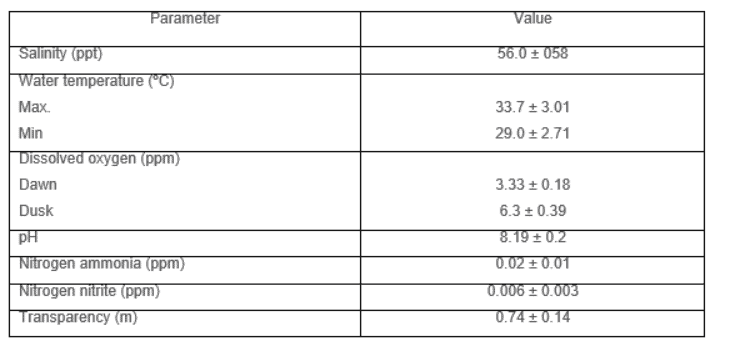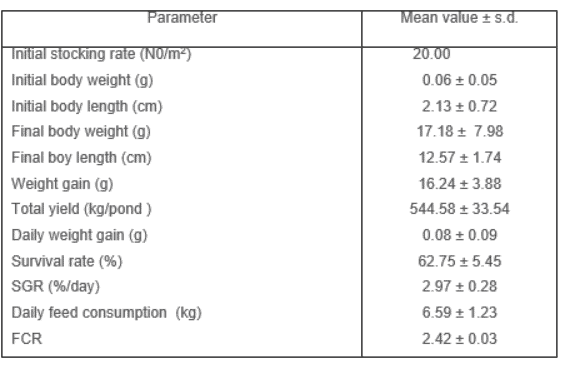Among the penaeid shrimp, the giant tiger prawn (Penaeus monodon), which inhibits the coasts of Australia, South Asia, South East Asia and East Africa, is the most farmed species(Coman et al., 2007). It is a euryhaline species and grows well in salinities ranging from 15 to 30 ppt and it is hardy and not readily stressed by handling(Bray and Lawrence, 1998). However, the dominance of this species is lately constrained by the dependency of the industry on wild caught broodstock and by the spread of viral diseases that have caused significant losses in production (Coman et al., 2005). In the United Arab Emirates (UAE), this species was first tried in the early 1990s by the Marine Resources Research Center, Ministry of Environment and Water in outdoor concrete grow-out tanks. These trials were terminated because the species failed to tolerate the low water temperatures (17°C) during wintertime(Al Ahbabi et al., 2002). In Saudi Arabia, the pond culture trials of the giant tiger on the Red Sea coast were also unsuccessful and revealed poor growth and survival rates under waters of over 40 ppt salinity where the average body size attained was only 30 gduring a 6-month grow-out period (Al-Thobaiti and James, 1996; Hasan and Das, 2002).
Abu Al Abyad Island, located west of Abu Dhabi, UAE, is characterized by high air temperatures (48°C) during summertime and in the winter season it reaches 12°C(Bottomley, 1996). The seawater temperatures in the area vary from as high as 36°C during summer to as low as 15°C during winter(Al Abdessalaam, 2002). This situation has contributed to the unusually high salinity averaging sometimes during summer up to 58 ppt. Due to all these existing factors, the island environment is always described as harsh and stressful for marine biota(Al Abdessalaam, 2002; Yousif et al., 2003). In spite of these tough conditions, the farming of the white shrimp (P. indicus) is successfully undertaken in the Island since 1997(Al Ahbabi et al., 2000; Yousif et al., 2003). These results have prompted the idea of experimenting the performance of P. monodon under similar harsh conditions. In this article, the results of the preliminary trials on the reproductive performance, growth and survival of wild giant tiger imported from Coetivy Island, Seychelles as well as those of captive broodstock grown under the hypersaline conditions of Abu Al Abyad Island are presented.
Reproductive performance
Two trials were carried out at the Aquaculture and Marine Studies Center (AMSC) at Abu Al abyad Island to test the reproductive performance of wild and pond-reared broodstock of the giant tiger. The wild group, received from Coetivy Island, Seychelles, consisted of 84 females averaging 102.34 ± 5.71 g and 84 males averaging 69.08 ± 6.37 g. The pond-reared prawns consisted of 120 females averaging 50.5 ± 4.61 g and 120 males averaging 37.43 ± 4.74 g. The pond-reared broodstock resulted from shrimp grown in two 0.25 ha liner ponds at 50-56 ppt natural water salinity for 15 months.
Both groups of giant tiger prawn were separately introduced to the hatchery where they were first stocked in the indoor 15 ton fiberglass conditioning tanks at 200 adults per tank (sex ratio of1:1). Initially they were disinfected with 100 ppm formalin for 10 minutes and then gradually acclimated to a salinity of 35 ppt. During the conditioning period the broodstocks were fed ad libitum with fresh meat of mussels, squid and crabs. After two weeks of acclimation, unilateral eyestalk ablation was applied to the females to induce maturation and animals from each conditioning tank were transferred to a 50-ton maturation tank in which water was exchanged daily at a rate of 50 percent. The water temperature and photoperiod were maintained at 27-29 °C and 14:10 (light:dark), respectively. Three to four days after ablation,females were checked for ovarian maturation and the gravid females (stage IV) were sorted daily and transferred to 400 l black fiberglass spawning-hatching tanks at a maximum stocking density of four females/tank. Immediately after spawning, the females were removed and returned to their respective maturation tanks. On the following day, the hatched nauplii were gently siphoned out from each spawning tank into a 100 μ collection bucket, counted and disinfected with 50 ppm formalin for 30 seconds and 20 ppm iodophore solution for 1 minute. The nauplii were gently rinsed in fresh seawater and stocked in a 10-ton rectangular fiberglass larval rearing tanks. A number of 116 viable spawns were obtained from the wild spawners yielding a total of 12.02 million nauplii (143.09 thousands/female). The pond-reared spawners gave only eight viable spawns which yielded a total of 0.58 million (4.85 thousands/female).
The larval rearing tank water was exchanged daily at a rate of fifty percent until the Z1 stage after which the exchange rate was gradually increased to 400 percent by stage Pl5. The hatchery feeding protocol included the microalgae Chaetoceros gracilis during nauplii and zoea stages (N5-Z3) and Tetraselmis sp. along with newly hatched instar I Artemia during mysis the M1-PL5 stages. Also, artificial plankton was given at all larval rearing stages. Water temperature in the larval rearing tanks was maintained at 27-28°C. When the animals were in the PL5-10 stages, the salinity in the larval rearing tanks was gradually raised over seven days until it reached the natural level of 50-56 ppt. The postlarvae were then transferred to the 40 ton outdoor concrete nursery tanks where they were grown for 40 days until they reached an average size of 0.06 ± 0.05 g.
These results clearly indicated that the reproductive performance of the wild group was much better than the pond-reared one. The low performance of the pond-reared spawners was probably due to their smaller size and to the fact that a major part of their life (10-12 months) was spent in hypersaline environment (50-56 ppt) before they were acclimatized and used for maturation compared to the naturally selected wild broodstock which represent a better physiological condition. It is also possible that the suboptimal environmental condirions (high salinity and temperature) or dietary factors might also have contributed to the low performance of pond-reared females(Coman et al., 2007). On the contrary, the giant tiger of Malaysian origin was successfully reared to adulthood under high salinity (38-52 ppt) and then acclimated for maturation under 35 ppt and the results showed comparable performance to wild broodstock of the same size(Willaim and Lawrence, 1998).
Grow-out
Before harvesting, juvenile shrimps in the nursing tanks were gradually acclimated to natural seawater of Al Abyad Island (56 ± 0.58 ppt) and then harvested and stocked in two 0.25 ha plastic lined ponds at a rate of 20 individuals/m². Seawater was supplied by pumping from a nearby dredged channel. A daily exchange rate of 10-15% was maintained throughout the 6-month grow-out period. Each pond was equipped with two paddle wheel aerators which were operated at night. Commercial pelleted feed (36.5% crude protein) was fed to the shrimp. The initial feeding rate was 10% of body weight daily and was gradually reduced to 2% of body weight by the time the shrimp were harvested. The daily feeding allowance was hand broadcast three times a day during the first three months and then adjusted to four times daily for the reminder of the grow-out period. At two week intervals, samples of a minimum of 100 individuals were trapped from each pond, weighed and measured and feed daily allowance was adjusted accordingly. Salinity, water temperature and dissolved oxygen (DO) were monitored daily while pH, nitrogen ammonia (NH4-N), nitrogen nitrite (No2-N) and transparency were measured at fortnightly intervals. The mean values (± s.d) of the water quality parameters recorded during the grow-out period are shown in Table 1.
Table 1: Mean values of water quality parameters recorded during the grow-out period of P. monodon in ponds ((± s.d)
After six months, both ponds were completely harvested, using special traps. The shrimps attained an average weight of 17.18 ± 7.98 g in six months of the culture period. The total yield per pond, the average daily weight gain, survival rate, specific growth rate and feed conversion ratio are presented in Table 2.
The growth of the giant tiger observed in the present trial is very poor compared to other studieswith domesticated giant tiger under lower salinities. Results from the grow-out trials with the domesticated giant tiger at varying densities and in salinities ranging from 10-25 ppt indicated a better yield and higher growth(Menasveta et al., 1994; Hoa, 2009) than reported in this trial. Although the specific growth rate (SGR %/day), 6.59 ± 1.23, was comparable to other studies(Ye Le et al., 2009), the feed conversion rate (FCR) was relatively very high (2.42 ± 0.03). The FCRs reported for the giant tiger usually range from 1.3 to 1.80(Hoa, 2009).
Table 2: Growth performance, survival and feed utilization efficiency of P. monodon in hypersaline ponds in a six-month period
Conclusions
The findings of this trial demonstrated that the giant tiger is not suitable for commercial production under the severe salinity and temperature conditions prevailing in Abu Al Abyad Island. Despite the considerable effort made to domesticate this species over the last few decades, difficulties still persist especially the nutritional requirements, and reproductive outputs of domesticated individuals. Trials conducted in another part of Abu Dhabi in 40-45 ppt also resulted in inferior growth and reproduction (Gopakumar, personal communication). The spawning performance of the pond-reared giant tiger in our study was found to be inferior compared to the wild spawners and it is doubtful if viable domesticated spawners can be produced to support a commercial culture operation.
May 2014





